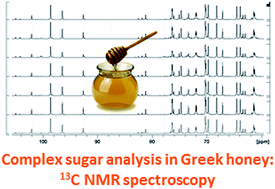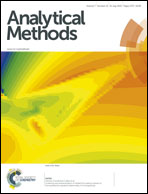Identification and quantitative determination of carbohydrate molecules in Greek honey by employing 13C NMR spectroscopy†
Abstract
A methodology based on 13C NMR spectroscopy was employed to detect and quantify fourteen mono-, di- and trisaccharide molecules in authentic Greek honey samples with no prior separation. Unambiguous assignment of 13C NMR chemical shifts has been achieved by means of two-dimensional NMR techniques using sugar model compounds. The quantitative 13C NMR method was rigorously validated (accuracy, linearity, range, limit of detection, etc.) using either single sugar molecules, or artificial mixtures of isoglucose (glucopyranose and fructose) and global mixtures of fourteen model compounds. Subsequent integration of appropriate signals in the 13C NMR spectra allowed the quantification of these compounds. The present methodology has been applied to authentic Greek honey samples and provided quantitative results for 28 sugar tautomers. The observed differentials in the content of these biomarkers amongst the various honey samples of different botanical origins are expected to form the basis for the development of a sensitive method that can be used to obtain valuable information about the authenticity of honey.


 Please wait while we load your content...
Please wait while we load your content...